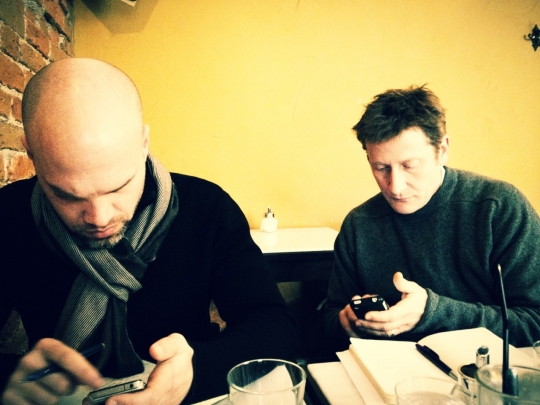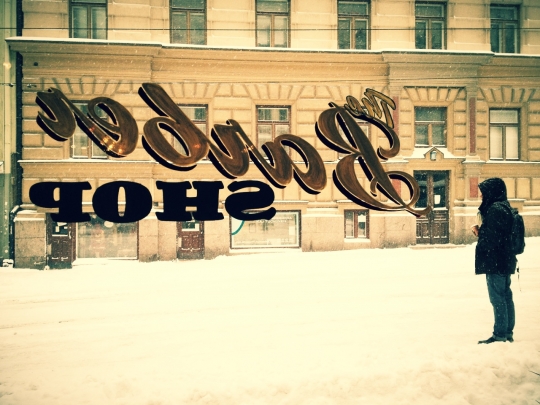The week we're about to write into the archives here was the bridge between January and February. So it was a while ago, but since it's Week 150 (!) and technically still about the first month of the year, I thought I would share a bit of our trajectory for 2012.
From time to time we have strategy days. We tend to do it once every 6-8 weeks and these days involve the team secluding ourselves outside of the office in a cafe or restaurant for extended review of all of the ongoing work, any upcoming possibilities, and the various loose ends.
It feels like a nice rigor: meet 1st thing in the morning, make a long list, sort it until the easy stuff is at the top and the important-but-nebulous stuff at the bottom, and start discussing items off one by one. Refill coffees when needed.
The core of the conversation was on the portfolio of ongoing projects. It looks something like this:
- Low2No: continues apace. We're in the thick of it now with intricate negotiations tied to our investment relationship between Sitra and our two development partners. This project is about developing and demonstrating the efficacy of a model for low carbon urban development.
- Design Exchange Programme: The first placement has started already. We're negotiating the next 1-2 placements and hope to announce them soon. This project is about testing the (hopefully positive) impacts of having designers sit within municipal and ministerial project teams to connect strategy to implementation through design methods and approaches.
- Helsinki Street Eats: we're basically done with a publication and doing final due diligence on image rights and things. In parallel we're getting to know the key actors in Helsinki around street food. This project is about catalyzing some of the recent organic developments in food culture into a way to open new opportunities in policy and business.
- Brickstarter: research is well underway and we're starting to get lost—in a good way. This project is about developing new ways for communities to make shared decisions that take into account shared values.
- Sitra internal development: Sitra is currently reflecting on the way that we pursue our mission of making Finland a leader in sustainable wellbeing and we're playing an active role in these workstreams.
This on its own feels like an ambitious lineup for 2012. But there's one thing which is conspicuously missing: HDL Global. Two years ago we culminated the activity of 2010 including three studios and three case studies by inviting a group of incredible people to reflect upon and speculate about the role of design within government. Two years on and it feels like there may be another useful check-in point. But we're cautious.
One of the core principles of HDL Global 2010, like HDL 1968 in fact, is that we felt it important to bring some new knowledge to the discussion. That's why we did the studios and case studies first. Too often gatherings and conferences end up being a bunch of people in the same place at the same time. Don't get me wrong, there's a lot of value in this, as simple as it can be, but conferences for their own sake are rarely transformative and often exhausting. When making a soup first you have to boil a stock, you know?
Our caution about HDL Global 2012 stems from the fact that our work is at a fragile stage right now: will it be ready to share in a meaningful way by the end of the year? Low2No is producing very important learnings, but some of it is still hard to share openly; the Design Exchange Programme is just off the ground; and Food and Brickstarter are only now revving their engines so to speak.
My suspicion is yes, we will have insights to share in 2012, but we're waiting a bit longer before making a final go/no-go call. The topics of the moment in our team are the cultures of decision making and an interest in coherence. These would be the themes of HDL Global 2012 if we had to choose right now.
The former has been simmering for years, but developed to a new level of articulation during a coffee conversation that Dan and I had last spring. We were speculating about why some people are more naturally able to see opportunities for change and others are more tied to the status quo. My proposition was (still is!) that people who have experience with making things are more aware of and better informed about the choices involved in making that thing, and therefore better able to see the degrees of freedom. To see where a different course of action could be taken, perhaps even desire it.
The process of making a soup, for instance, helps give you insight into ingredients, first of all. But also the proportions between the ingredients and the sequencing and techniques of their handling. The first few times one makes a particular soup they may follow the recipe strictly, but an experienced chef is able to move away from the recipe and work on the principles underneath them. What starts out as a singular choice—to soup, or not to soup—devolves into many, many more discrete questions about all the nuances of the dish.
This applies to car engines, train schedules, literature, and legal documents as much as it does to soup. The more you know a thing, the better you see the landscape of possibility and, I would argue, the better you are equipped to question it.
When we talk about cultures of decision making, we're interested in the ability of individuals to see this landscape of choices, as well as their ability to navigate that landscape to consider alternatives, and what factors they use to evaluate alternatives and make a decision. In a way, we're pursuing a behavioral economics of the creative act, or a future studies of the present. These fields are stirring in our heads and reading lists along with neuroscience, psychology, and ethics.
In our various projects we're working towards something along the lines of a comparative study of cultures of decision making. When we work with the city on food regulations or talk to a community about how they decided to build a wind farm we're not interested so much in food or green energy, per se. Rather, it's the ways that they succeeded or struggled to make coherent decisions… which you might remember as the second bubbling theme of interest lately.
I think it was Marco who first articulated that "design is ultimately about bringing coherence" to a situation or thing. This feels like a useful evolution of the phrase that we've previously used to describe strategic design. We usually talk about strategic design bringing the same craft and care to decisions as traditional designers give to objects. "Coherence" is nice because it describes something specific and it also works well for both traditional and strategic definitions of design activity.
As we look at and explore these various cultures of decision making one of the things we're deciphering is how they construct and act on notions of coherence. What looks coherent to one person or community my not be so for another. It's a fascinating way to crack open a discussion. Or at least we're having fun with it, but maybe that's because we're all pretty nerdy for this stuff when you get right down to it.
What's on the top of your mind these days?






You bring up an interesting question: why are some people more naturally able to see opportunities for change? In a talk by the founder of Endeavor, she mentions that the language around entrepreneurship, the word entrepreneur for example, simply doesn't exist in some cultures, which becomes a huge hinderance in being able to see opportunities. I imagine there are a whole host of other factors and look forward to seeing where HDL takes this question!
posted by Satsuko VanAntwerp — 4 weeks ago
I wonder if you have considered the principles of bread-making, rather than soup, in formulating a suitable analogy for the "recipe" of success. Perhaps it's because I've been making it through winter by kneading to excess in my kitchen, but it bears exploration.
The key thing you learn after making batch upon batch of bread is the weaving of art, science and often unseen forces that culminate in a humble loaf. The fundamentals of the slow rise, starter sponges (seeded from previous doughs), injections of steam at precise moments to form a signature crust — all suggest the role of patient craft and apprenticeship in seeing the techniques involved in particular results. And this from a base of perhaps four ingredients! How complex it must be for groups of people, much less urban constructs.
In a professional kitchen, the amount of yeast required to conduct a rise decreases over time — a result of ambient yeast accrued in the kitchen from frequent use. Thus, even a well-tested formula in skilled hands is subject to change within a severely local context.
Perhaps my theory is more crust than crumb, but your entry brought to mind a vivid portrait of trying to master and define something that is equally as elusive without something bordering an obsessive immersion!
posted by Jeremy Jones — 4 weeks ago
You might not be surprised to learn that we are a bit obsessed with food metaphors in the office, and often talk about the role of design as a bit of yeast to make the dough rise. I suppose it can be rather self serving, but the reason it comes up again and again is in trying to explain that strategic design does not need to overwhelm a project (in terms of people, for instance) but it also can't be left out. Depends on your recipe, I suppose. Sometimes you need a good roti, you know?
posted by Bryan Boyer — 4 weeks ago